BUMKT5902 Marketing Report: Customer Value and Proposition Analysis
VerifiedAdded on 2023/01/12
|10
|3421
|100
Report
AI Summary
This report examines the concepts of customer value and value proposition within the context of marketing management, using a case study of Coles supermarket. It begins by defining these core terms and explaining their significance in driving business success. The report then analyzes the strategies employed by both UK and local supermarkets, specifically Coles in Parramatta, to deliver value to customers. This includes an assessment of how value propositions are communicated and how customer segments are targeted. The report concludes with recommendations for Coles, based on the findings. The study provides insights into the importance of customer satisfaction, loyalty, and competitive advantage in the retail industry.
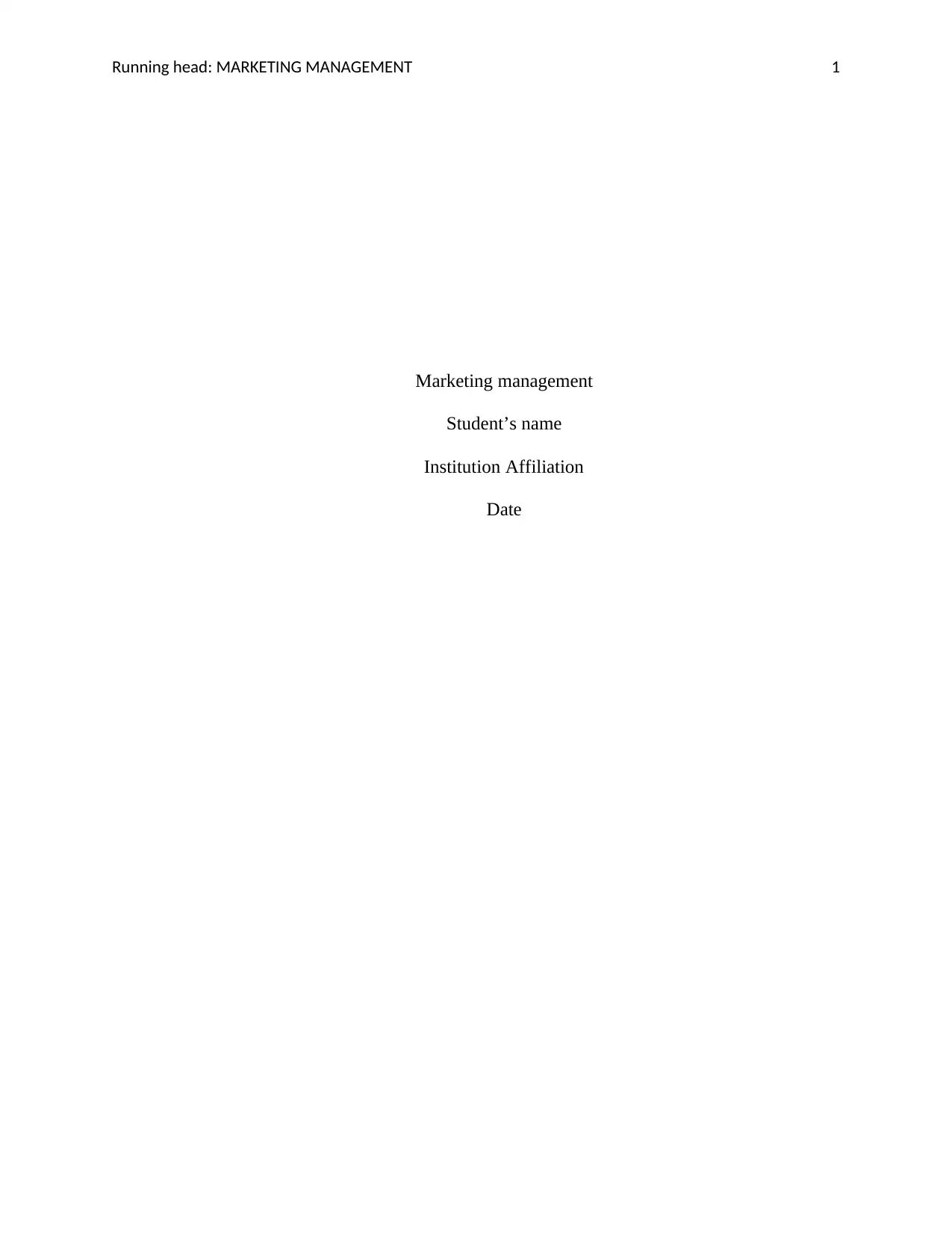
Running head: MARKETING MANAGEMENT 1
Marketing management
Student’s name
Institution Affiliation
Date
Marketing management
Student’s name
Institution Affiliation
Date
Paraphrase This Document
Need a fresh take? Get an instant paraphrase of this document with our AI Paraphraser
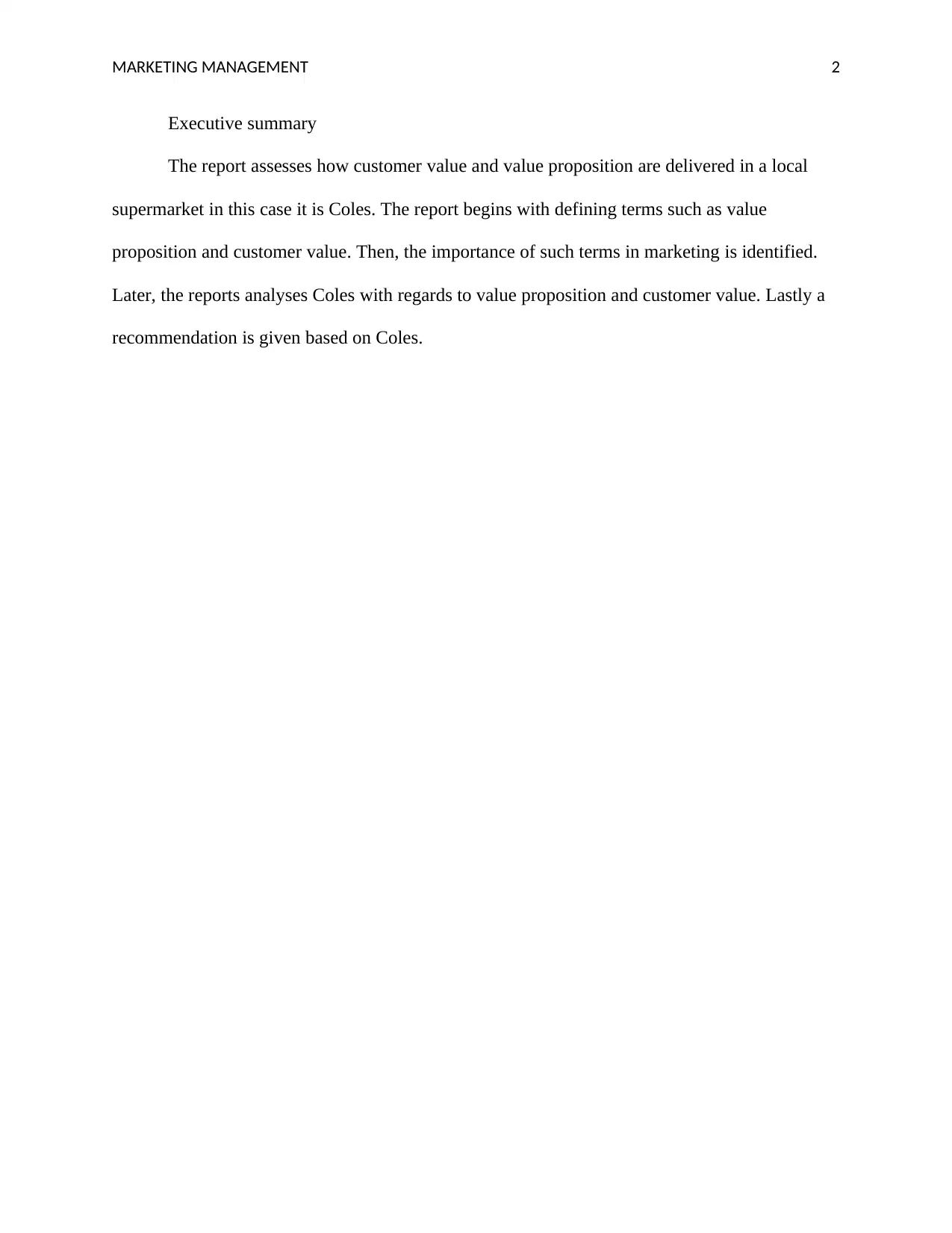
MARKETING MANAGEMENT 2
Executive summary
The report assesses how customer value and value proposition are delivered in a local
supermarket in this case it is Coles. The report begins with defining terms such as value
proposition and customer value. Then, the importance of such terms in marketing is identified.
Later, the reports analyses Coles with regards to value proposition and customer value. Lastly a
recommendation is given based on Coles.
Executive summary
The report assesses how customer value and value proposition are delivered in a local
supermarket in this case it is Coles. The report begins with defining terms such as value
proposition and customer value. Then, the importance of such terms in marketing is identified.
Later, the reports analyses Coles with regards to value proposition and customer value. Lastly a
recommendation is given based on Coles.
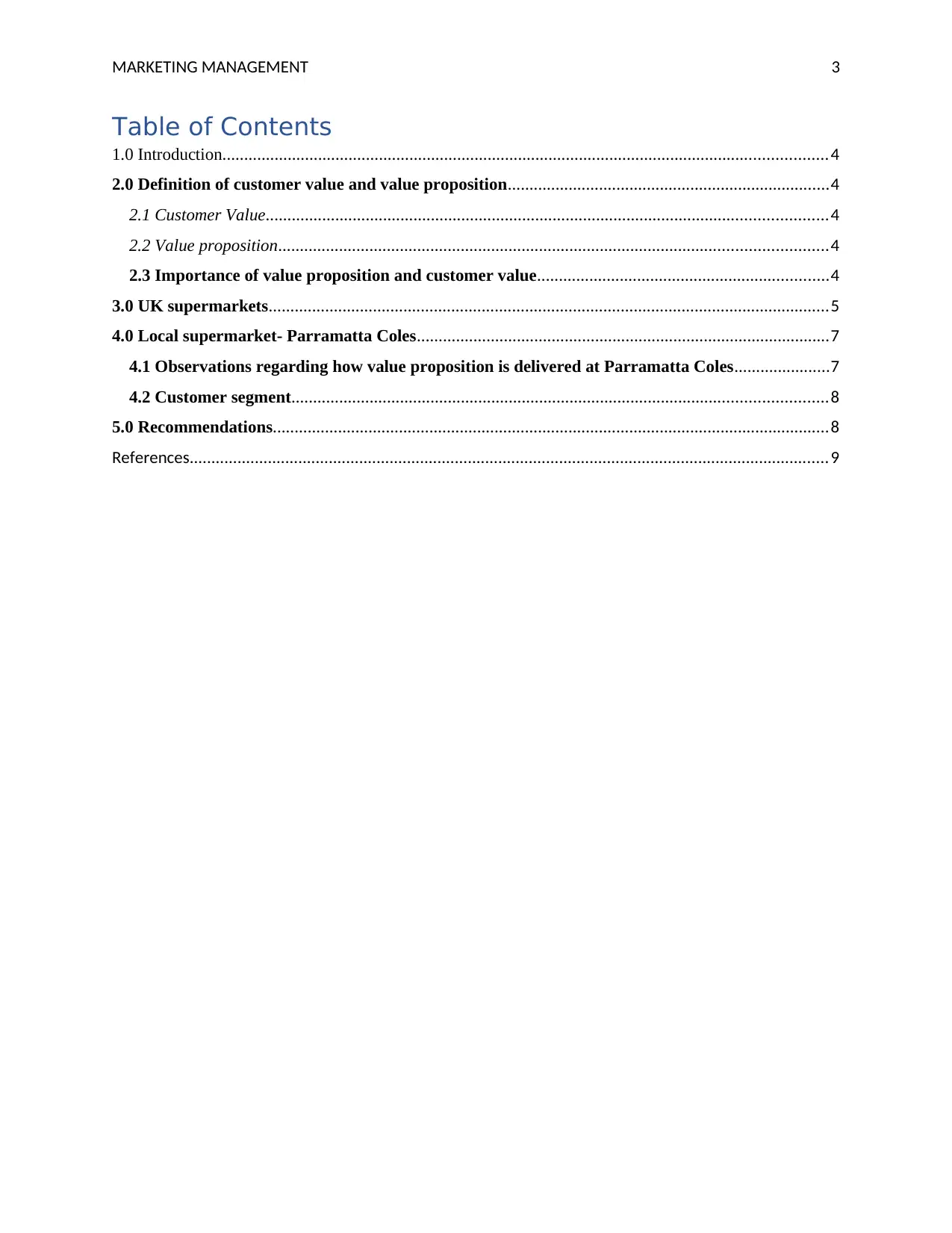
MARKETING MANAGEMENT 3
Table of Contents
1.0 Introduction...........................................................................................................................................4
2.0 Definition of customer value and value proposition..........................................................................4
2.1 Customer Value.................................................................................................................................4
2.2 Value proposition..............................................................................................................................4
2.3 Importance of value proposition and customer value...................................................................4
3.0 UK supermarkets.................................................................................................................................5
4.0 Local supermarket- Parramatta Coles...............................................................................................7
4.1 Observations regarding how value proposition is delivered at Parramatta Coles......................7
4.2 Customer segment...........................................................................................................................8
5.0 Recommendations................................................................................................................................8
References...................................................................................................................................................9
Table of Contents
1.0 Introduction...........................................................................................................................................4
2.0 Definition of customer value and value proposition..........................................................................4
2.1 Customer Value.................................................................................................................................4
2.2 Value proposition..............................................................................................................................4
2.3 Importance of value proposition and customer value...................................................................4
3.0 UK supermarkets.................................................................................................................................5
4.0 Local supermarket- Parramatta Coles...............................................................................................7
4.1 Observations regarding how value proposition is delivered at Parramatta Coles......................7
4.2 Customer segment...........................................................................................................................8
5.0 Recommendations................................................................................................................................8
References...................................................................................................................................................9
⊘ This is a preview!⊘
Do you want full access?
Subscribe today to unlock all pages.

Trusted by 1+ million students worldwide
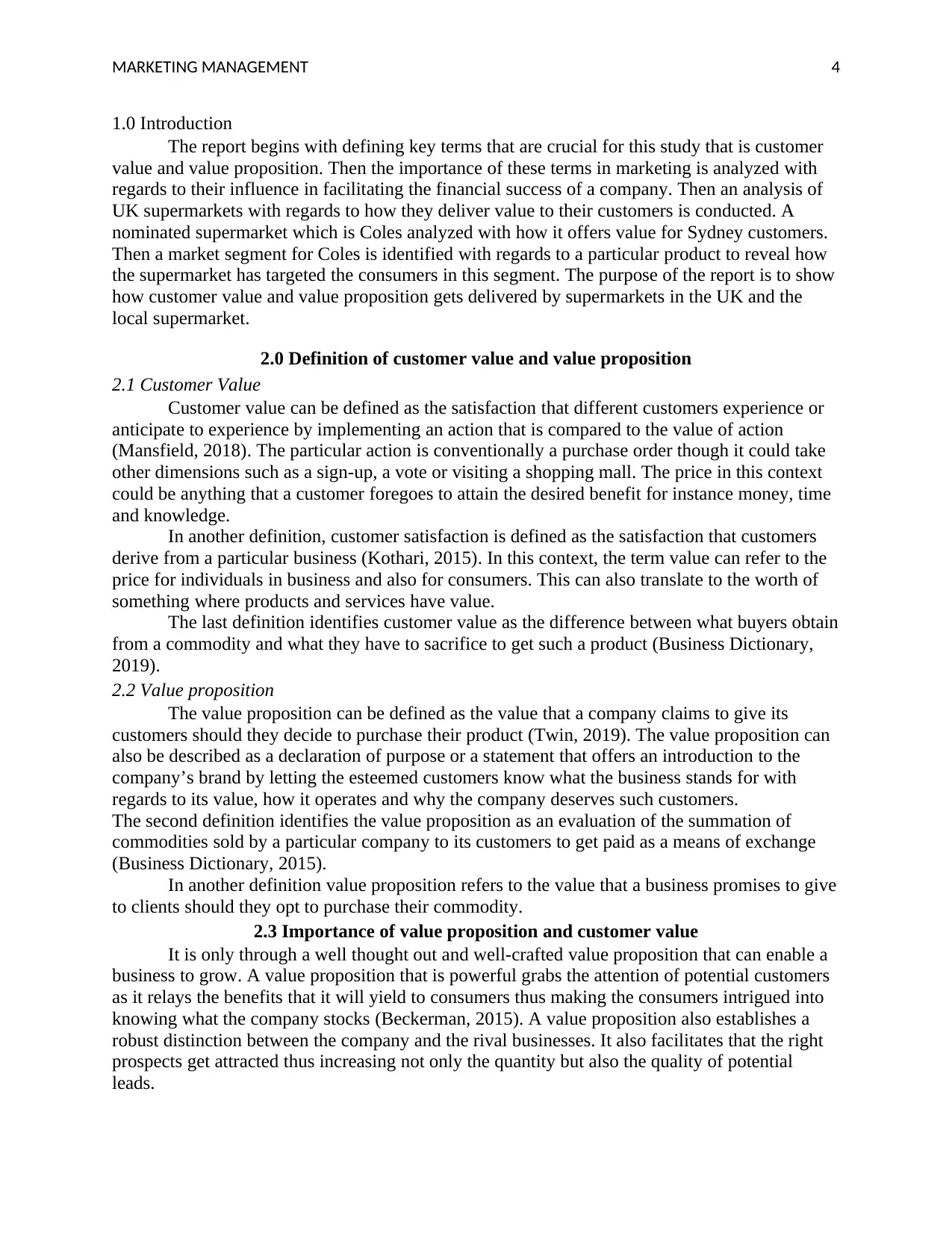
MARKETING MANAGEMENT 4
1.0 Introduction
The report begins with defining key terms that are crucial for this study that is customer
value and value proposition. Then the importance of these terms in marketing is analyzed with
regards to their influence in facilitating the financial success of a company. Then an analysis of
UK supermarkets with regards to how they deliver value to their customers is conducted. A
nominated supermarket which is Coles analyzed with how it offers value for Sydney customers.
Then a market segment for Coles is identified with regards to a particular product to reveal how
the supermarket has targeted the consumers in this segment. The purpose of the report is to show
how customer value and value proposition gets delivered by supermarkets in the UK and the
local supermarket.
2.0 Definition of customer value and value proposition
2.1 Customer Value
Customer value can be defined as the satisfaction that different customers experience or
anticipate to experience by implementing an action that is compared to the value of action
(Mansfield, 2018). The particular action is conventionally a purchase order though it could take
other dimensions such as a sign-up, a vote or visiting a shopping mall. The price in this context
could be anything that a customer foregoes to attain the desired benefit for instance money, time
and knowledge.
In another definition, customer satisfaction is defined as the satisfaction that customers
derive from a particular business (Kothari, 2015). In this context, the term value can refer to the
price for individuals in business and also for consumers. This can also translate to the worth of
something where products and services have value.
The last definition identifies customer value as the difference between what buyers obtain
from a commodity and what they have to sacrifice to get such a product (Business Dictionary,
2019).
2.2 Value proposition
The value proposition can be defined as the value that a company claims to give its
customers should they decide to purchase their product (Twin, 2019). The value proposition can
also be described as a declaration of purpose or a statement that offers an introduction to the
company’s brand by letting the esteemed customers know what the business stands for with
regards to its value, how it operates and why the company deserves such customers.
The second definition identifies the value proposition as an evaluation of the summation of
commodities sold by a particular company to its customers to get paid as a means of exchange
(Business Dictionary, 2015).
In another definition value proposition refers to the value that a business promises to give
to clients should they opt to purchase their commodity.
2.3 Importance of value proposition and customer value
It is only through a well thought out and well-crafted value proposition that can enable a
business to grow. A value proposition that is powerful grabs the attention of potential customers
as it relays the benefits that it will yield to consumers thus making the consumers intrigued into
knowing what the company stocks (Beckerman, 2015). A value proposition also establishes a
robust distinction between the company and the rival businesses. It also facilitates that the right
prospects get attracted thus increasing not only the quantity but also the quality of potential
leads.
1.0 Introduction
The report begins with defining key terms that are crucial for this study that is customer
value and value proposition. Then the importance of these terms in marketing is analyzed with
regards to their influence in facilitating the financial success of a company. Then an analysis of
UK supermarkets with regards to how they deliver value to their customers is conducted. A
nominated supermarket which is Coles analyzed with how it offers value for Sydney customers.
Then a market segment for Coles is identified with regards to a particular product to reveal how
the supermarket has targeted the consumers in this segment. The purpose of the report is to show
how customer value and value proposition gets delivered by supermarkets in the UK and the
local supermarket.
2.0 Definition of customer value and value proposition
2.1 Customer Value
Customer value can be defined as the satisfaction that different customers experience or
anticipate to experience by implementing an action that is compared to the value of action
(Mansfield, 2018). The particular action is conventionally a purchase order though it could take
other dimensions such as a sign-up, a vote or visiting a shopping mall. The price in this context
could be anything that a customer foregoes to attain the desired benefit for instance money, time
and knowledge.
In another definition, customer satisfaction is defined as the satisfaction that customers
derive from a particular business (Kothari, 2015). In this context, the term value can refer to the
price for individuals in business and also for consumers. This can also translate to the worth of
something where products and services have value.
The last definition identifies customer value as the difference between what buyers obtain
from a commodity and what they have to sacrifice to get such a product (Business Dictionary,
2019).
2.2 Value proposition
The value proposition can be defined as the value that a company claims to give its
customers should they decide to purchase their product (Twin, 2019). The value proposition can
also be described as a declaration of purpose or a statement that offers an introduction to the
company’s brand by letting the esteemed customers know what the business stands for with
regards to its value, how it operates and why the company deserves such customers.
The second definition identifies the value proposition as an evaluation of the summation of
commodities sold by a particular company to its customers to get paid as a means of exchange
(Business Dictionary, 2015).
In another definition value proposition refers to the value that a business promises to give
to clients should they opt to purchase their commodity.
2.3 Importance of value proposition and customer value
It is only through a well thought out and well-crafted value proposition that can enable a
business to grow. A value proposition that is powerful grabs the attention of potential customers
as it relays the benefits that it will yield to consumers thus making the consumers intrigued into
knowing what the company stocks (Beckerman, 2015). A value proposition also establishes a
robust distinction between the company and the rival businesses. It also facilitates that the right
prospects get attracted thus increasing not only the quantity but also the quality of potential
leads.
Paraphrase This Document
Need a fresh take? Get an instant paraphrase of this document with our AI Paraphraser
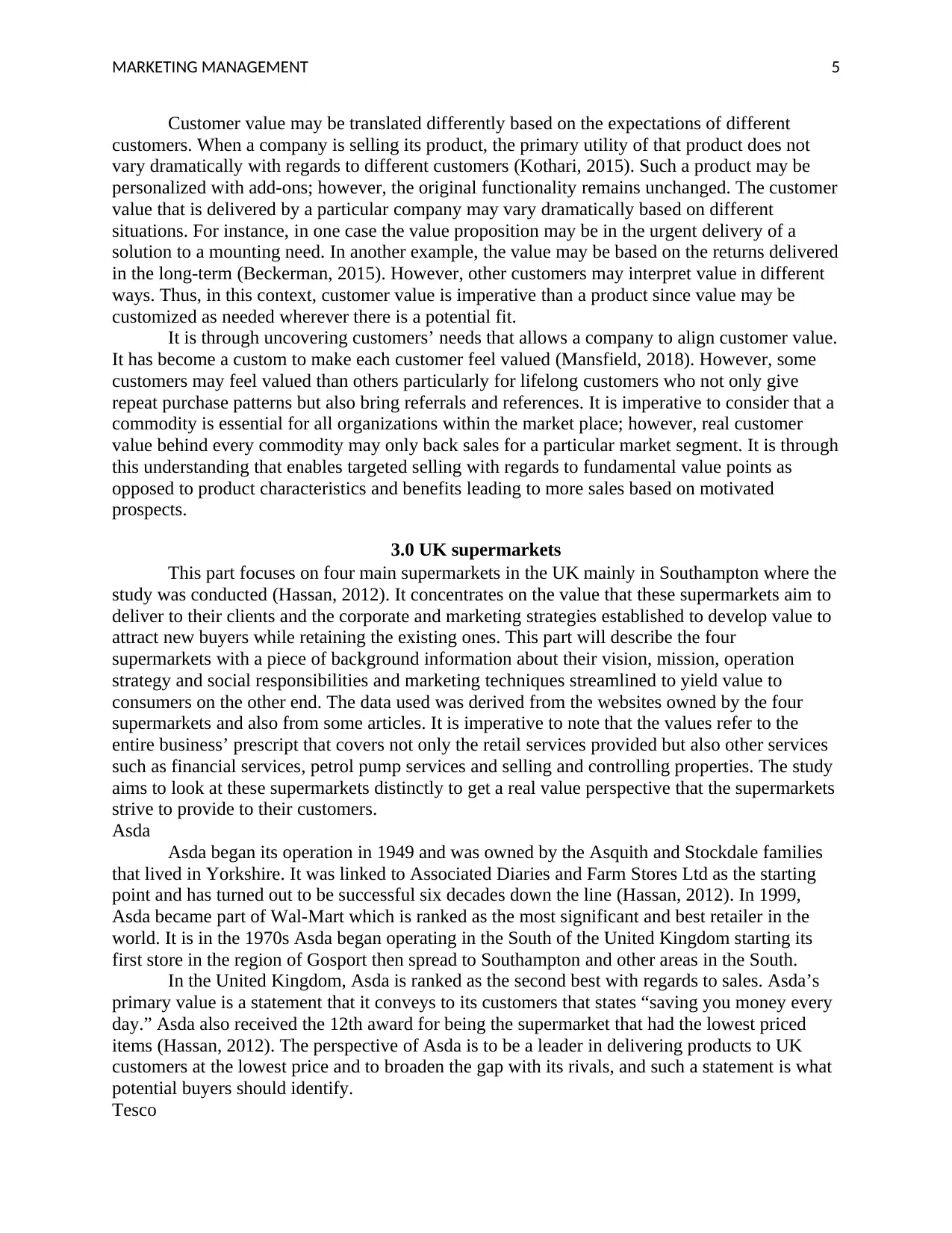
MARKETING MANAGEMENT 5
Customer value may be translated differently based on the expectations of different
customers. When a company is selling its product, the primary utility of that product does not
vary dramatically with regards to different customers (Kothari, 2015). Such a product may be
personalized with add-ons; however, the original functionality remains unchanged. The customer
value that is delivered by a particular company may vary dramatically based on different
situations. For instance, in one case the value proposition may be in the urgent delivery of a
solution to a mounting need. In another example, the value may be based on the returns delivered
in the long-term (Beckerman, 2015). However, other customers may interpret value in different
ways. Thus, in this context, customer value is imperative than a product since value may be
customized as needed wherever there is a potential fit.
It is through uncovering customers’ needs that allows a company to align customer value.
It has become a custom to make each customer feel valued (Mansfield, 2018). However, some
customers may feel valued than others particularly for lifelong customers who not only give
repeat purchase patterns but also bring referrals and references. It is imperative to consider that a
commodity is essential for all organizations within the market place; however, real customer
value behind every commodity may only back sales for a particular market segment. It is through
this understanding that enables targeted selling with regards to fundamental value points as
opposed to product characteristics and benefits leading to more sales based on motivated
prospects.
3.0 UK supermarkets
This part focuses on four main supermarkets in the UK mainly in Southampton where the
study was conducted (Hassan, 2012). It concentrates on the value that these supermarkets aim to
deliver to their clients and the corporate and marketing strategies established to develop value to
attract new buyers while retaining the existing ones. This part will describe the four
supermarkets with a piece of background information about their vision, mission, operation
strategy and social responsibilities and marketing techniques streamlined to yield value to
consumers on the other end. The data used was derived from the websites owned by the four
supermarkets and also from some articles. It is imperative to note that the values refer to the
entire business’ prescript that covers not only the retail services provided but also other services
such as financial services, petrol pump services and selling and controlling properties. The study
aims to look at these supermarkets distinctly to get a real value perspective that the supermarkets
strive to provide to their customers.
Asda
Asda began its operation in 1949 and was owned by the Asquith and Stockdale families
that lived in Yorkshire. It was linked to Associated Diaries and Farm Stores Ltd as the starting
point and has turned out to be successful six decades down the line (Hassan, 2012). In 1999,
Asda became part of Wal-Mart which is ranked as the most significant and best retailer in the
world. It is in the 1970s Asda began operating in the South of the United Kingdom starting its
first store in the region of Gosport then spread to Southampton and other areas in the South.
In the United Kingdom, Asda is ranked as the second best with regards to sales. Asda’s
primary value is a statement that it conveys to its customers that states “saving you money every
day.” Asda also received the 12th award for being the supermarket that had the lowest priced
items (Hassan, 2012). The perspective of Asda is to be a leader in delivering products to UK
customers at the lowest price and to broaden the gap with its rivals, and such a statement is what
potential buyers should identify.
Tesco
Customer value may be translated differently based on the expectations of different
customers. When a company is selling its product, the primary utility of that product does not
vary dramatically with regards to different customers (Kothari, 2015). Such a product may be
personalized with add-ons; however, the original functionality remains unchanged. The customer
value that is delivered by a particular company may vary dramatically based on different
situations. For instance, in one case the value proposition may be in the urgent delivery of a
solution to a mounting need. In another example, the value may be based on the returns delivered
in the long-term (Beckerman, 2015). However, other customers may interpret value in different
ways. Thus, in this context, customer value is imperative than a product since value may be
customized as needed wherever there is a potential fit.
It is through uncovering customers’ needs that allows a company to align customer value.
It has become a custom to make each customer feel valued (Mansfield, 2018). However, some
customers may feel valued than others particularly for lifelong customers who not only give
repeat purchase patterns but also bring referrals and references. It is imperative to consider that a
commodity is essential for all organizations within the market place; however, real customer
value behind every commodity may only back sales for a particular market segment. It is through
this understanding that enables targeted selling with regards to fundamental value points as
opposed to product characteristics and benefits leading to more sales based on motivated
prospects.
3.0 UK supermarkets
This part focuses on four main supermarkets in the UK mainly in Southampton where the
study was conducted (Hassan, 2012). It concentrates on the value that these supermarkets aim to
deliver to their clients and the corporate and marketing strategies established to develop value to
attract new buyers while retaining the existing ones. This part will describe the four
supermarkets with a piece of background information about their vision, mission, operation
strategy and social responsibilities and marketing techniques streamlined to yield value to
consumers on the other end. The data used was derived from the websites owned by the four
supermarkets and also from some articles. It is imperative to note that the values refer to the
entire business’ prescript that covers not only the retail services provided but also other services
such as financial services, petrol pump services and selling and controlling properties. The study
aims to look at these supermarkets distinctly to get a real value perspective that the supermarkets
strive to provide to their customers.
Asda
Asda began its operation in 1949 and was owned by the Asquith and Stockdale families
that lived in Yorkshire. It was linked to Associated Diaries and Farm Stores Ltd as the starting
point and has turned out to be successful six decades down the line (Hassan, 2012). In 1999,
Asda became part of Wal-Mart which is ranked as the most significant and best retailer in the
world. It is in the 1970s Asda began operating in the South of the United Kingdom starting its
first store in the region of Gosport then spread to Southampton and other areas in the South.
In the United Kingdom, Asda is ranked as the second best with regards to sales. Asda’s
primary value is a statement that it conveys to its customers that states “saving you money every
day.” Asda also received the 12th award for being the supermarket that had the lowest priced
items (Hassan, 2012). The perspective of Asda is to be a leader in delivering products to UK
customers at the lowest price and to broaden the gap with its rivals, and such a statement is what
potential buyers should identify.
Tesco
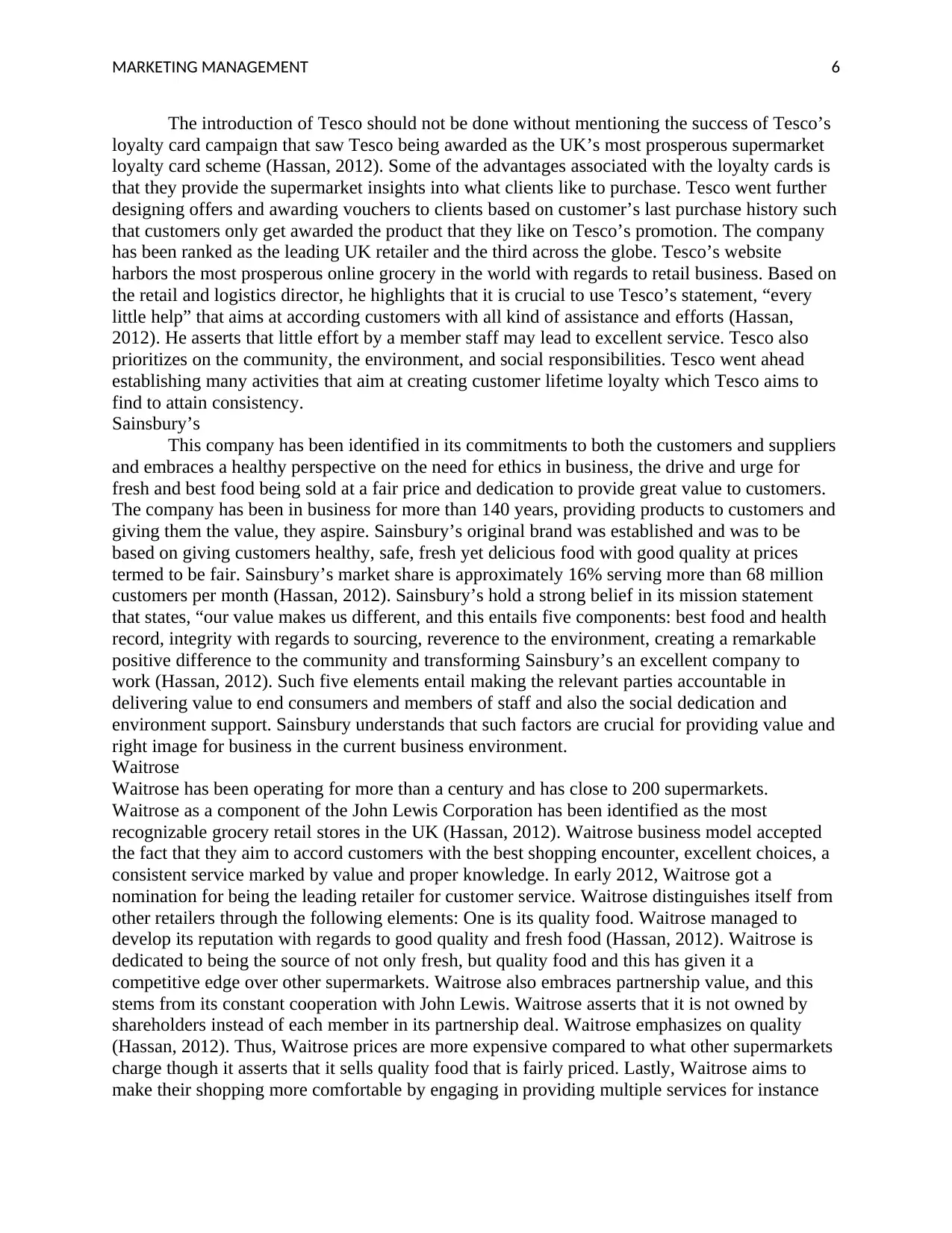
MARKETING MANAGEMENT 6
The introduction of Tesco should not be done without mentioning the success of Tesco’s
loyalty card campaign that saw Tesco being awarded as the UK’s most prosperous supermarket
loyalty card scheme (Hassan, 2012). Some of the advantages associated with the loyalty cards is
that they provide the supermarket insights into what clients like to purchase. Tesco went further
designing offers and awarding vouchers to clients based on customer’s last purchase history such
that customers only get awarded the product that they like on Tesco’s promotion. The company
has been ranked as the leading UK retailer and the third across the globe. Tesco’s website
harbors the most prosperous online grocery in the world with regards to retail business. Based on
the retail and logistics director, he highlights that it is crucial to use Tesco’s statement, “every
little help” that aims at according customers with all kind of assistance and efforts (Hassan,
2012). He asserts that little effort by a member staff may lead to excellent service. Tesco also
prioritizes on the community, the environment, and social responsibilities. Tesco went ahead
establishing many activities that aim at creating customer lifetime loyalty which Tesco aims to
find to attain consistency.
Sainsbury’s
This company has been identified in its commitments to both the customers and suppliers
and embraces a healthy perspective on the need for ethics in business, the drive and urge for
fresh and best food being sold at a fair price and dedication to provide great value to customers.
The company has been in business for more than 140 years, providing products to customers and
giving them the value, they aspire. Sainsbury’s original brand was established and was to be
based on giving customers healthy, safe, fresh yet delicious food with good quality at prices
termed to be fair. Sainsbury’s market share is approximately 16% serving more than 68 million
customers per month (Hassan, 2012). Sainsbury’s hold a strong belief in its mission statement
that states, “our value makes us different, and this entails five components: best food and health
record, integrity with regards to sourcing, reverence to the environment, creating a remarkable
positive difference to the community and transforming Sainsbury’s an excellent company to
work (Hassan, 2012). Such five elements entail making the relevant parties accountable in
delivering value to end consumers and members of staff and also the social dedication and
environment support. Sainsbury understands that such factors are crucial for providing value and
right image for business in the current business environment.
Waitrose
Waitrose has been operating for more than a century and has close to 200 supermarkets.
Waitrose as a component of the John Lewis Corporation has been identified as the most
recognizable grocery retail stores in the UK (Hassan, 2012). Waitrose business model accepted
the fact that they aim to accord customers with the best shopping encounter, excellent choices, a
consistent service marked by value and proper knowledge. In early 2012, Waitrose got a
nomination for being the leading retailer for customer service. Waitrose distinguishes itself from
other retailers through the following elements: One is its quality food. Waitrose managed to
develop its reputation with regards to good quality and fresh food (Hassan, 2012). Waitrose is
dedicated to being the source of not only fresh, but quality food and this has given it a
competitive edge over other supermarkets. Waitrose also embraces partnership value, and this
stems from its constant cooperation with John Lewis. Waitrose asserts that it is not owned by
shareholders instead of each member in its partnership deal. Waitrose emphasizes on quality
(Hassan, 2012). Thus, Waitrose prices are more expensive compared to what other supermarkets
charge though it asserts that it sells quality food that is fairly priced. Lastly, Waitrose aims to
make their shopping more comfortable by engaging in providing multiple services for instance
The introduction of Tesco should not be done without mentioning the success of Tesco’s
loyalty card campaign that saw Tesco being awarded as the UK’s most prosperous supermarket
loyalty card scheme (Hassan, 2012). Some of the advantages associated with the loyalty cards is
that they provide the supermarket insights into what clients like to purchase. Tesco went further
designing offers and awarding vouchers to clients based on customer’s last purchase history such
that customers only get awarded the product that they like on Tesco’s promotion. The company
has been ranked as the leading UK retailer and the third across the globe. Tesco’s website
harbors the most prosperous online grocery in the world with regards to retail business. Based on
the retail and logistics director, he highlights that it is crucial to use Tesco’s statement, “every
little help” that aims at according customers with all kind of assistance and efforts (Hassan,
2012). He asserts that little effort by a member staff may lead to excellent service. Tesco also
prioritizes on the community, the environment, and social responsibilities. Tesco went ahead
establishing many activities that aim at creating customer lifetime loyalty which Tesco aims to
find to attain consistency.
Sainsbury’s
This company has been identified in its commitments to both the customers and suppliers
and embraces a healthy perspective on the need for ethics in business, the drive and urge for
fresh and best food being sold at a fair price and dedication to provide great value to customers.
The company has been in business for more than 140 years, providing products to customers and
giving them the value, they aspire. Sainsbury’s original brand was established and was to be
based on giving customers healthy, safe, fresh yet delicious food with good quality at prices
termed to be fair. Sainsbury’s market share is approximately 16% serving more than 68 million
customers per month (Hassan, 2012). Sainsbury’s hold a strong belief in its mission statement
that states, “our value makes us different, and this entails five components: best food and health
record, integrity with regards to sourcing, reverence to the environment, creating a remarkable
positive difference to the community and transforming Sainsbury’s an excellent company to
work (Hassan, 2012). Such five elements entail making the relevant parties accountable in
delivering value to end consumers and members of staff and also the social dedication and
environment support. Sainsbury understands that such factors are crucial for providing value and
right image for business in the current business environment.
Waitrose
Waitrose has been operating for more than a century and has close to 200 supermarkets.
Waitrose as a component of the John Lewis Corporation has been identified as the most
recognizable grocery retail stores in the UK (Hassan, 2012). Waitrose business model accepted
the fact that they aim to accord customers with the best shopping encounter, excellent choices, a
consistent service marked by value and proper knowledge. In early 2012, Waitrose got a
nomination for being the leading retailer for customer service. Waitrose distinguishes itself from
other retailers through the following elements: One is its quality food. Waitrose managed to
develop its reputation with regards to good quality and fresh food (Hassan, 2012). Waitrose is
dedicated to being the source of not only fresh, but quality food and this has given it a
competitive edge over other supermarkets. Waitrose also embraces partnership value, and this
stems from its constant cooperation with John Lewis. Waitrose asserts that it is not owned by
shareholders instead of each member in its partnership deal. Waitrose emphasizes on quality
(Hassan, 2012). Thus, Waitrose prices are more expensive compared to what other supermarkets
charge though it asserts that it sells quality food that is fairly priced. Lastly, Waitrose aims to
make their shopping more comfortable by engaging in providing multiple services for instance
⊘ This is a preview!⊘
Do you want full access?
Subscribe today to unlock all pages.

Trusted by 1+ million students worldwide
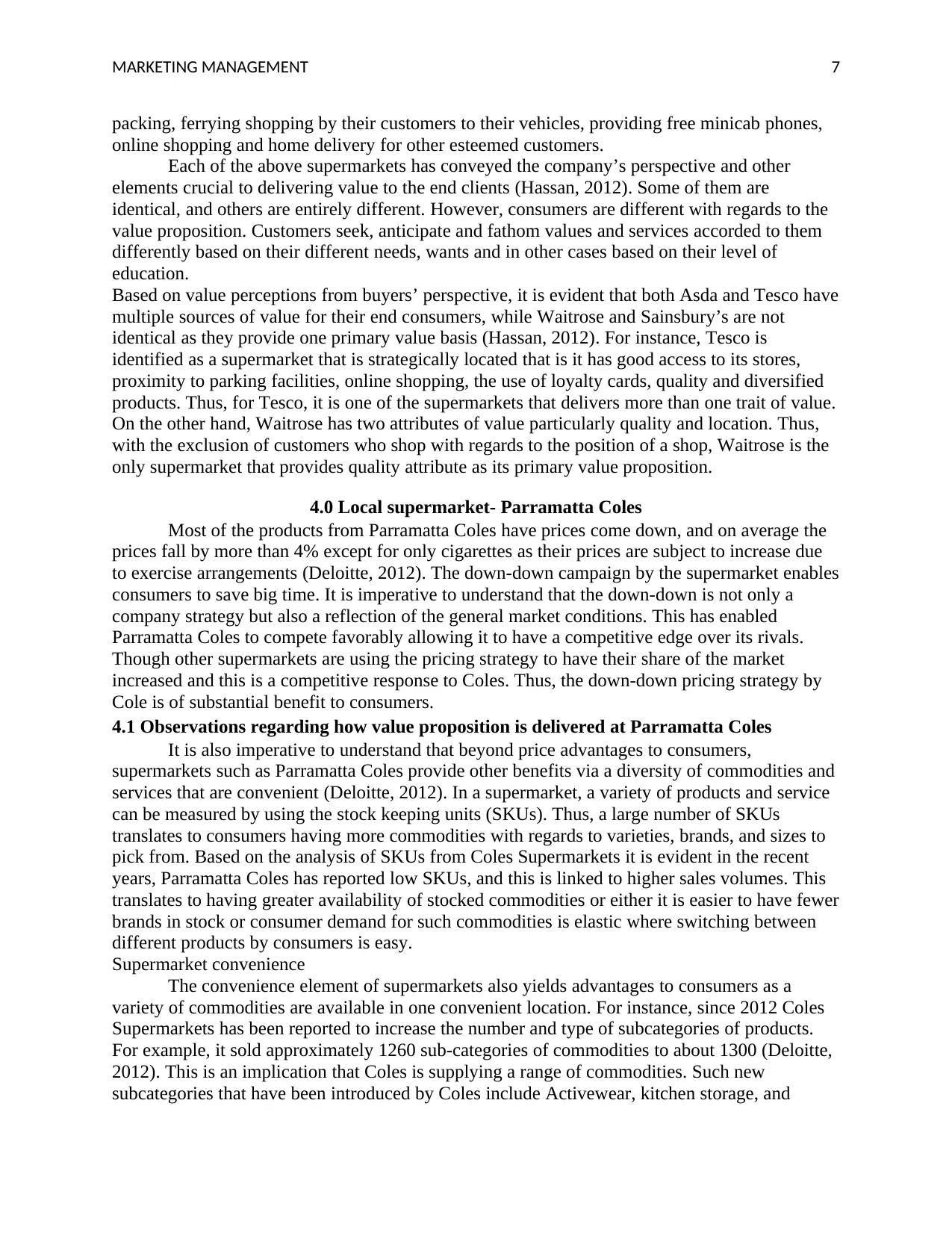
MARKETING MANAGEMENT 7
packing, ferrying shopping by their customers to their vehicles, providing free minicab phones,
online shopping and home delivery for other esteemed customers.
Each of the above supermarkets has conveyed the company’s perspective and other
elements crucial to delivering value to the end clients (Hassan, 2012). Some of them are
identical, and others are entirely different. However, consumers are different with regards to the
value proposition. Customers seek, anticipate and fathom values and services accorded to them
differently based on their different needs, wants and in other cases based on their level of
education.
Based on value perceptions from buyers’ perspective, it is evident that both Asda and Tesco have
multiple sources of value for their end consumers, while Waitrose and Sainsbury’s are not
identical as they provide one primary value basis (Hassan, 2012). For instance, Tesco is
identified as a supermarket that is strategically located that is it has good access to its stores,
proximity to parking facilities, online shopping, the use of loyalty cards, quality and diversified
products. Thus, for Tesco, it is one of the supermarkets that delivers more than one trait of value.
On the other hand, Waitrose has two attributes of value particularly quality and location. Thus,
with the exclusion of customers who shop with regards to the position of a shop, Waitrose is the
only supermarket that provides quality attribute as its primary value proposition.
4.0 Local supermarket- Parramatta Coles
Most of the products from Parramatta Coles have prices come down, and on average the
prices fall by more than 4% except for only cigarettes as their prices are subject to increase due
to exercise arrangements (Deloitte, 2012). The down-down campaign by the supermarket enables
consumers to save big time. It is imperative to understand that the down-down is not only a
company strategy but also a reflection of the general market conditions. This has enabled
Parramatta Coles to compete favorably allowing it to have a competitive edge over its rivals.
Though other supermarkets are using the pricing strategy to have their share of the market
increased and this is a competitive response to Coles. Thus, the down-down pricing strategy by
Cole is of substantial benefit to consumers.
4.1 Observations regarding how value proposition is delivered at Parramatta Coles
It is also imperative to understand that beyond price advantages to consumers,
supermarkets such as Parramatta Coles provide other benefits via a diversity of commodities and
services that are convenient (Deloitte, 2012). In a supermarket, a variety of products and service
can be measured by using the stock keeping units (SKUs). Thus, a large number of SKUs
translates to consumers having more commodities with regards to varieties, brands, and sizes to
pick from. Based on the analysis of SKUs from Coles Supermarkets it is evident in the recent
years, Parramatta Coles has reported low SKUs, and this is linked to higher sales volumes. This
translates to having greater availability of stocked commodities or either it is easier to have fewer
brands in stock or consumer demand for such commodities is elastic where switching between
different products by consumers is easy.
Supermarket convenience
The convenience element of supermarkets also yields advantages to consumers as a
variety of commodities are available in one convenient location. For instance, since 2012 Coles
Supermarkets has been reported to increase the number and type of subcategories of products.
For example, it sold approximately 1260 sub-categories of commodities to about 1300 (Deloitte,
2012). This is an implication that Coles is supplying a range of commodities. Such new
subcategories that have been introduced by Coles include Activewear, kitchen storage, and
packing, ferrying shopping by their customers to their vehicles, providing free minicab phones,
online shopping and home delivery for other esteemed customers.
Each of the above supermarkets has conveyed the company’s perspective and other
elements crucial to delivering value to the end clients (Hassan, 2012). Some of them are
identical, and others are entirely different. However, consumers are different with regards to the
value proposition. Customers seek, anticipate and fathom values and services accorded to them
differently based on their different needs, wants and in other cases based on their level of
education.
Based on value perceptions from buyers’ perspective, it is evident that both Asda and Tesco have
multiple sources of value for their end consumers, while Waitrose and Sainsbury’s are not
identical as they provide one primary value basis (Hassan, 2012). For instance, Tesco is
identified as a supermarket that is strategically located that is it has good access to its stores,
proximity to parking facilities, online shopping, the use of loyalty cards, quality and diversified
products. Thus, for Tesco, it is one of the supermarkets that delivers more than one trait of value.
On the other hand, Waitrose has two attributes of value particularly quality and location. Thus,
with the exclusion of customers who shop with regards to the position of a shop, Waitrose is the
only supermarket that provides quality attribute as its primary value proposition.
4.0 Local supermarket- Parramatta Coles
Most of the products from Parramatta Coles have prices come down, and on average the
prices fall by more than 4% except for only cigarettes as their prices are subject to increase due
to exercise arrangements (Deloitte, 2012). The down-down campaign by the supermarket enables
consumers to save big time. It is imperative to understand that the down-down is not only a
company strategy but also a reflection of the general market conditions. This has enabled
Parramatta Coles to compete favorably allowing it to have a competitive edge over its rivals.
Though other supermarkets are using the pricing strategy to have their share of the market
increased and this is a competitive response to Coles. Thus, the down-down pricing strategy by
Cole is of substantial benefit to consumers.
4.1 Observations regarding how value proposition is delivered at Parramatta Coles
It is also imperative to understand that beyond price advantages to consumers,
supermarkets such as Parramatta Coles provide other benefits via a diversity of commodities and
services that are convenient (Deloitte, 2012). In a supermarket, a variety of products and service
can be measured by using the stock keeping units (SKUs). Thus, a large number of SKUs
translates to consumers having more commodities with regards to varieties, brands, and sizes to
pick from. Based on the analysis of SKUs from Coles Supermarkets it is evident in the recent
years, Parramatta Coles has reported low SKUs, and this is linked to higher sales volumes. This
translates to having greater availability of stocked commodities or either it is easier to have fewer
brands in stock or consumer demand for such commodities is elastic where switching between
different products by consumers is easy.
Supermarket convenience
The convenience element of supermarkets also yields advantages to consumers as a
variety of commodities are available in one convenient location. For instance, since 2012 Coles
Supermarkets has been reported to increase the number and type of subcategories of products.
For example, it sold approximately 1260 sub-categories of commodities to about 1300 (Deloitte,
2012). This is an implication that Coles is supplying a range of commodities. Such new
subcategories that have been introduced by Coles include Activewear, kitchen storage, and
Paraphrase This Document
Need a fresh take? Get an instant paraphrase of this document with our AI Paraphraser
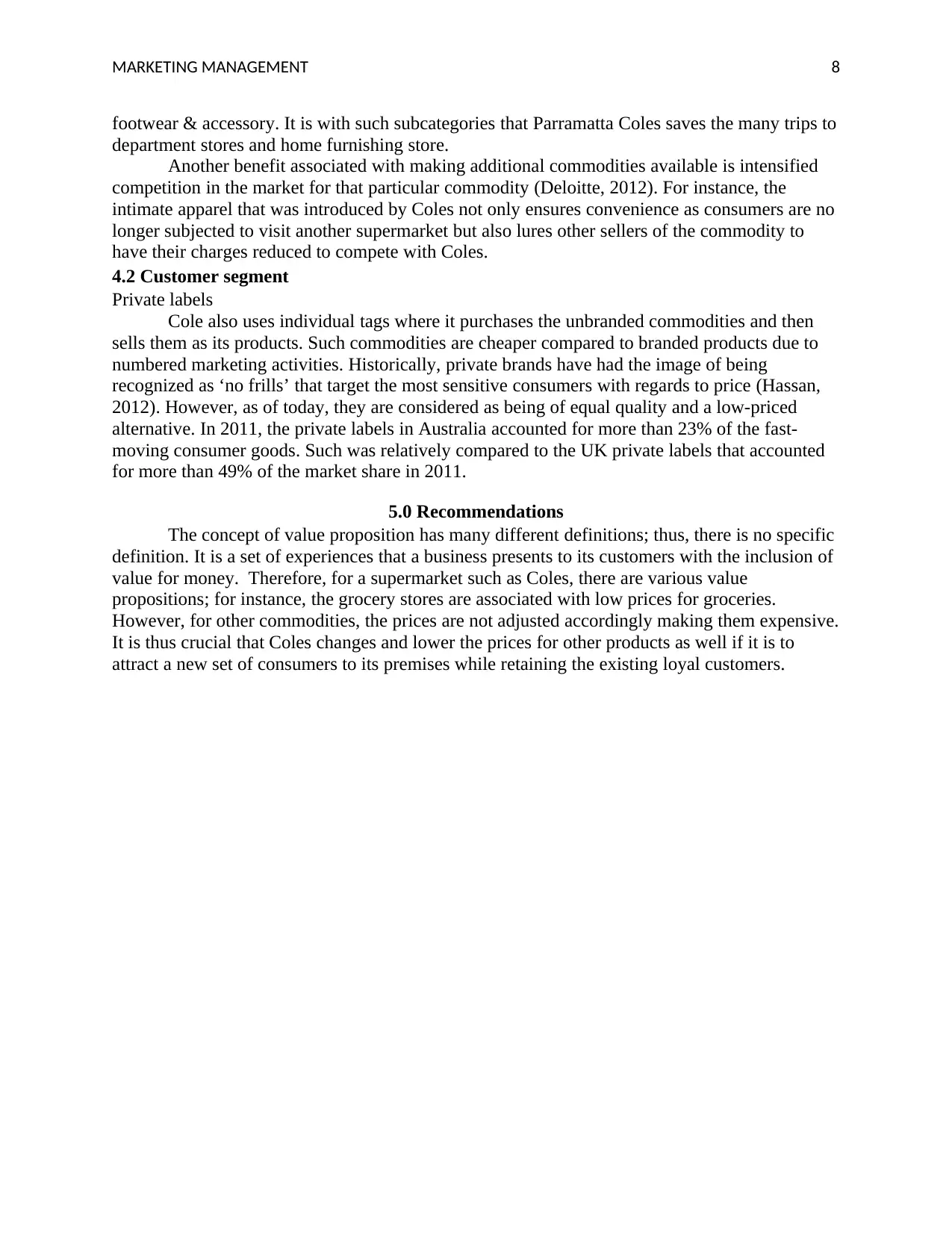
MARKETING MANAGEMENT 8
footwear & accessory. It is with such subcategories that Parramatta Coles saves the many trips to
department stores and home furnishing store.
Another benefit associated with making additional commodities available is intensified
competition in the market for that particular commodity (Deloitte, 2012). For instance, the
intimate apparel that was introduced by Coles not only ensures convenience as consumers are no
longer subjected to visit another supermarket but also lures other sellers of the commodity to
have their charges reduced to compete with Coles.
4.2 Customer segment
Private labels
Cole also uses individual tags where it purchases the unbranded commodities and then
sells them as its products. Such commodities are cheaper compared to branded products due to
numbered marketing activities. Historically, private brands have had the image of being
recognized as ‘no frills’ that target the most sensitive consumers with regards to price (Hassan,
2012). However, as of today, they are considered as being of equal quality and a low-priced
alternative. In 2011, the private labels in Australia accounted for more than 23% of the fast-
moving consumer goods. Such was relatively compared to the UK private labels that accounted
for more than 49% of the market share in 2011.
5.0 Recommendations
The concept of value proposition has many different definitions; thus, there is no specific
definition. It is a set of experiences that a business presents to its customers with the inclusion of
value for money. Therefore, for a supermarket such as Coles, there are various value
propositions; for instance, the grocery stores are associated with low prices for groceries.
However, for other commodities, the prices are not adjusted accordingly making them expensive.
It is thus crucial that Coles changes and lower the prices for other products as well if it is to
attract a new set of consumers to its premises while retaining the existing loyal customers.
footwear & accessory. It is with such subcategories that Parramatta Coles saves the many trips to
department stores and home furnishing store.
Another benefit associated with making additional commodities available is intensified
competition in the market for that particular commodity (Deloitte, 2012). For instance, the
intimate apparel that was introduced by Coles not only ensures convenience as consumers are no
longer subjected to visit another supermarket but also lures other sellers of the commodity to
have their charges reduced to compete with Coles.
4.2 Customer segment
Private labels
Cole also uses individual tags where it purchases the unbranded commodities and then
sells them as its products. Such commodities are cheaper compared to branded products due to
numbered marketing activities. Historically, private brands have had the image of being
recognized as ‘no frills’ that target the most sensitive consumers with regards to price (Hassan,
2012). However, as of today, they are considered as being of equal quality and a low-priced
alternative. In 2011, the private labels in Australia accounted for more than 23% of the fast-
moving consumer goods. Such was relatively compared to the UK private labels that accounted
for more than 49% of the market share in 2011.
5.0 Recommendations
The concept of value proposition has many different definitions; thus, there is no specific
definition. It is a set of experiences that a business presents to its customers with the inclusion of
value for money. Therefore, for a supermarket such as Coles, there are various value
propositions; for instance, the grocery stores are associated with low prices for groceries.
However, for other commodities, the prices are not adjusted accordingly making them expensive.
It is thus crucial that Coles changes and lower the prices for other products as well if it is to
attract a new set of consumers to its premises while retaining the existing loyal customers.
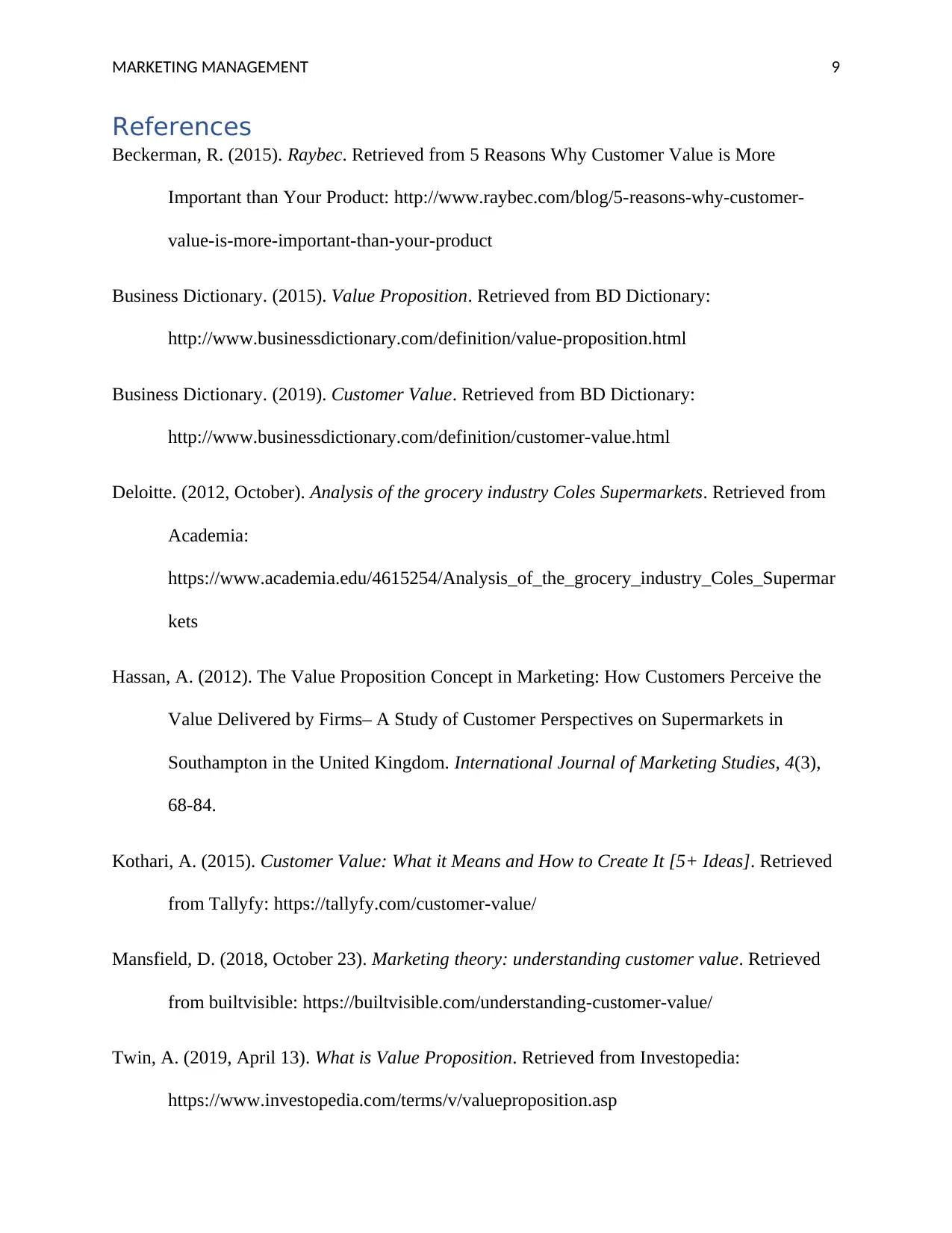
MARKETING MANAGEMENT 9
References
Beckerman, R. (2015). Raybec. Retrieved from 5 Reasons Why Customer Value is More
Important than Your Product: http://www.raybec.com/blog/5-reasons-why-customer-
value-is-more-important-than-your-product
Business Dictionary. (2015). Value Proposition. Retrieved from BD Dictionary:
http://www.businessdictionary.com/definition/value-proposition.html
Business Dictionary. (2019). Customer Value. Retrieved from BD Dictionary:
http://www.businessdictionary.com/definition/customer-value.html
Deloitte. (2012, October). Analysis of the grocery industry Coles Supermarkets. Retrieved from
Academia:
https://www.academia.edu/4615254/Analysis_of_the_grocery_industry_Coles_Supermar
kets
Hassan, A. (2012). The Value Proposition Concept in Marketing: How Customers Perceive the
Value Delivered by Firms– A Study of Customer Perspectives on Supermarkets in
Southampton in the United Kingdom. International Journal of Marketing Studies, 4(3),
68-84.
Kothari, A. (2015). Customer Value: What it Means and How to Create It [5+ Ideas]. Retrieved
from Tallyfy: https://tallyfy.com/customer-value/
Mansfield, D. (2018, October 23). Marketing theory: understanding customer value. Retrieved
from builtvisible: https://builtvisible.com/understanding-customer-value/
Twin, A. (2019, April 13). What is Value Proposition. Retrieved from Investopedia:
https://www.investopedia.com/terms/v/valueproposition.asp
References
Beckerman, R. (2015). Raybec. Retrieved from 5 Reasons Why Customer Value is More
Important than Your Product: http://www.raybec.com/blog/5-reasons-why-customer-
value-is-more-important-than-your-product
Business Dictionary. (2015). Value Proposition. Retrieved from BD Dictionary:
http://www.businessdictionary.com/definition/value-proposition.html
Business Dictionary. (2019). Customer Value. Retrieved from BD Dictionary:
http://www.businessdictionary.com/definition/customer-value.html
Deloitte. (2012, October). Analysis of the grocery industry Coles Supermarkets. Retrieved from
Academia:
https://www.academia.edu/4615254/Analysis_of_the_grocery_industry_Coles_Supermar
kets
Hassan, A. (2012). The Value Proposition Concept in Marketing: How Customers Perceive the
Value Delivered by Firms– A Study of Customer Perspectives on Supermarkets in
Southampton in the United Kingdom. International Journal of Marketing Studies, 4(3),
68-84.
Kothari, A. (2015). Customer Value: What it Means and How to Create It [5+ Ideas]. Retrieved
from Tallyfy: https://tallyfy.com/customer-value/
Mansfield, D. (2018, October 23). Marketing theory: understanding customer value. Retrieved
from builtvisible: https://builtvisible.com/understanding-customer-value/
Twin, A. (2019, April 13). What is Value Proposition. Retrieved from Investopedia:
https://www.investopedia.com/terms/v/valueproposition.asp
⊘ This is a preview!⊘
Do you want full access?
Subscribe today to unlock all pages.

Trusted by 1+ million students worldwide

MARKETING MANAGEMENT 10
1 out of 10
Related Documents
Your All-in-One AI-Powered Toolkit for Academic Success.
+13062052269
info@desklib.com
Available 24*7 on WhatsApp / Email
![[object Object]](/_next/static/media/star-bottom.7253800d.svg)
Unlock your academic potential
Copyright © 2020–2025 A2Z Services. All Rights Reserved. Developed and managed by ZUCOL.




